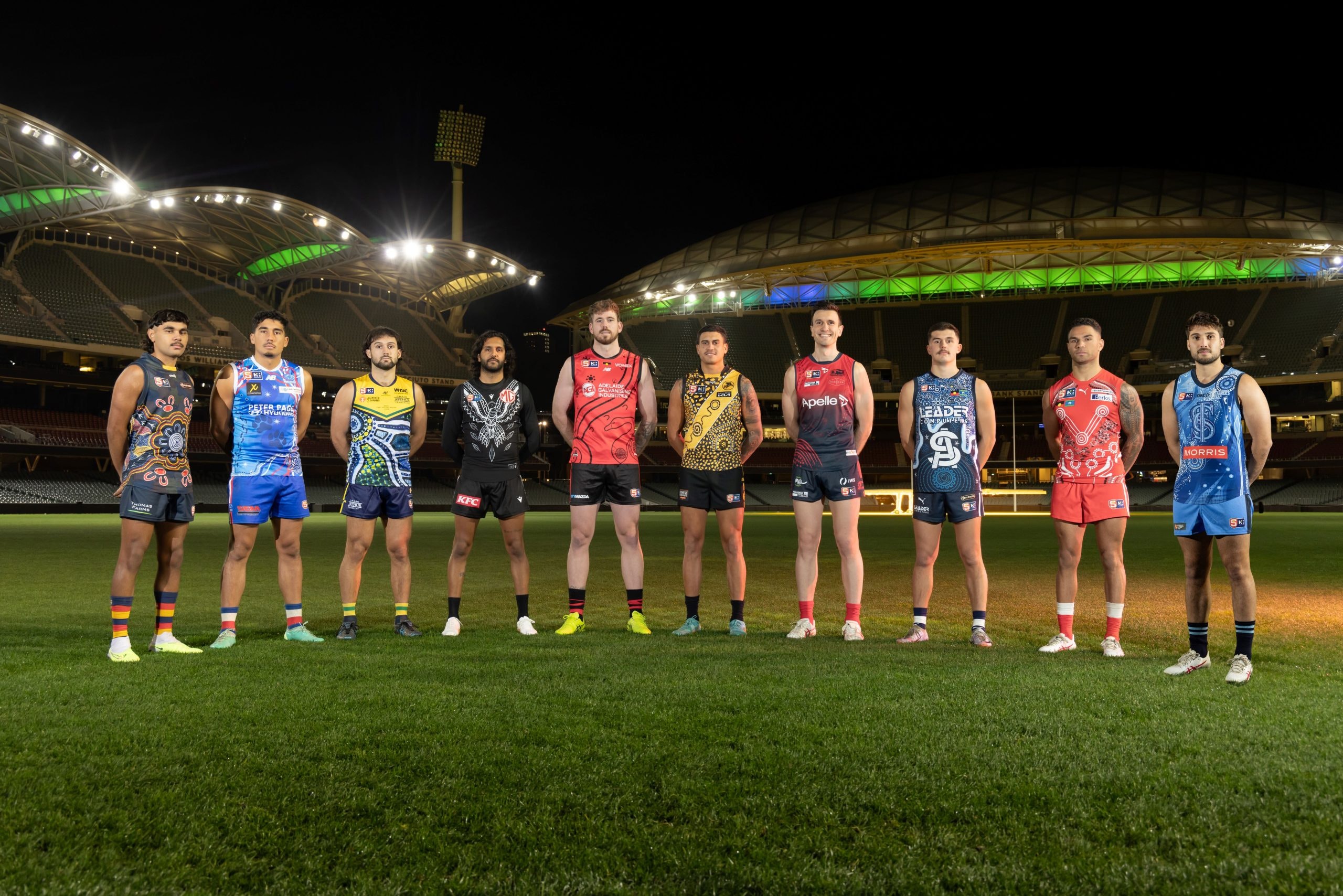
2023 First Nations Round Guernsey Designs
Hostplus SANFL League players (L to R) Blayne O'Loughlin (Adelaide), Anzac Lochowiak (Central), Tyran Hill (Eagles), Anthony Wilson (Port), Kaiden Brand (West), James Bell (Glenelg), Matt Panos (Norwood), Hayden Sampson (South), Frank Szekely (North), James Battersby (Sturt) wear their club's specially designed First Nations Round guernseys. Picture - David Mariuz
As we head into the Hostplus SANFL League’s First Nations Round, to be held across two weekends, here is every club’s stunning guernsey design and the unique stories behind them.
First Nations Round is a celebration and recognition of all SANFL Aboriginal and Torres Strait Islander players past and present who have made, and continue to make, such a significant contribution to our national game.
Adelaide’s 2023 First Nations guernsey features a heartfelt family link with AFLW premiership player Danielle Ponter.
The guernsey – to be worn by all three of Adelaide’s teams – has been designed by Anmatyerr educator and artist April Napangardi Campbell from the Ti Tree community in the Northern Territory.
Campbell is Ponter’s Aunty and the two met recently in Adelaide, having only ever spoken over the phone after their family lost connection when Ponter’s grandfather on her mother’s side was forcibly removed from traditional lands as a two-year-old.
The primary theme of this year’s guernsey design is connection, which has extra special meaning given the opportunity to create the special piece of artwork connected Ponter and Campbell for the first time.
Campbell’s design centres on connection as one Club, inclusive of all Crows players, staff, members, fans and communities. It aims to create a sense of belonging, strength and community, while celebrating current and past Indigenous players.
Ponter said the thin white line surrounding the red path of the crow tracks, which represents the journey of players, was what resonated most for her.
“The thin lines show the pathways for young people to play football and follow in our footsteps and that’s something that’s really important to me especially as an Indigenous person and a player,” she said.
“I want to be leaving a good pathway to show Indigenous kids and people that they are able to be in this position and be a footballer, and maybe even a Crows player.”
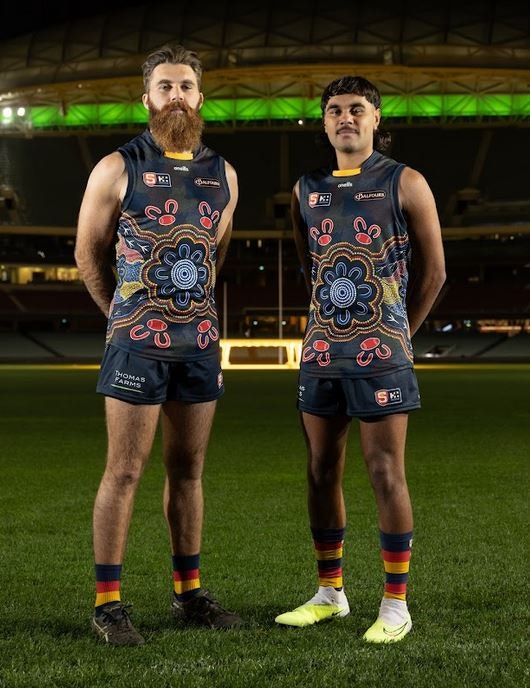
Isaya McKenzie (left) and Blayne O’Loughlin.
There are many elements which form Central District’s First Nations Round guernsey, including connection, spirituality and dreamtime stories.
Front of Guernsey
Red, blue and white lines represent song lines that travel all over the country carrying dreamtime stories.
The foot prints are the players’ journey and are also significant as they symbolise families travelling across the country while the stars symbolise our ancestors.
The circles with the connected lines are the connection between the players and their journey to Central District Football Club.
The circle with the 18 people around it symbolises the oval, the club and the team coming together as one.
The shield, person and the spear represents when we are out on the field we protect, look after, and support our teammates.
The Southern Cross symbolises Aboriginal spirituality.
Back of Guernsey
Totems:
Mihail Lochowiak’s totum is the eagle.
Anzac Lochowiak’s totum is the fire
Jacob Lochowiak’s totum is the lizard
The connected circles with the dots represent the dreamtime (living in harmony with the land, spiritual connection with everything)
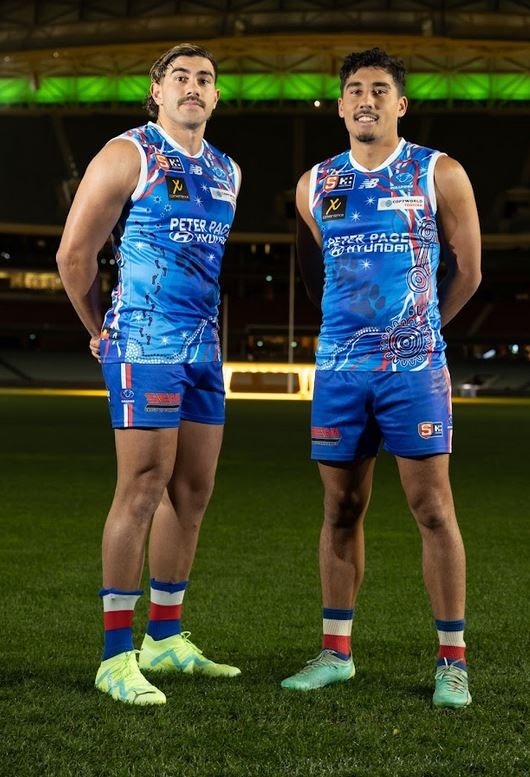
Mihail (left) and Anzac Lochowiak.
Anwerne apurte irreme – we are all coming together.
Designed by Amanda Turner, who hails from Ltyentye Apurte (Santa Teresa), around 85km south east of Alice Springs, the overall theme of the guernsey is about the Glenelg community and coming together.
The guernsey represents not only the players, but the whole training group, the people within the club and the Bays community – it brings us all together. The circles represent the ground we walk on and everyone coming together as one.
The design also reflects upon the club going through the journey of the football season across the year, as well as the club’s ‘all in’ trademark.
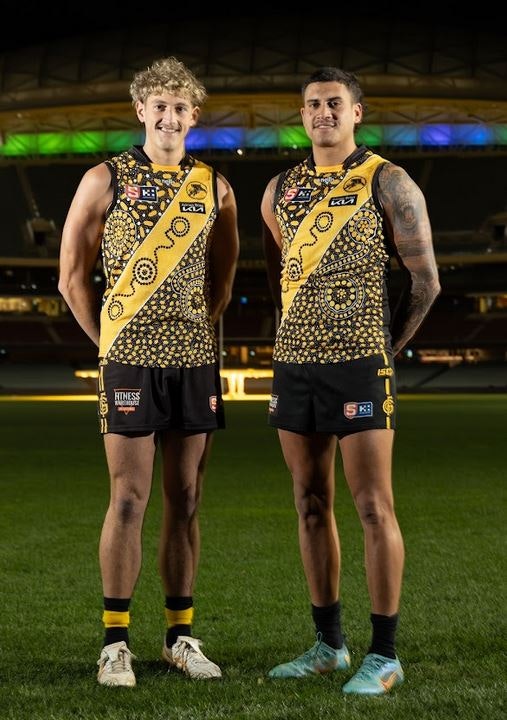
Connor McLeod (left) and James Bell.
Painted by Monica Turner-Collins Arrernte Anmatyerr, North Adelaide’s guernsey was also worn during the Hostplus SANFLW League First Nations Round earlier this year.
The design meaning:
The circles represent the women’s journey connecting with the men’s, following down and connecting to the wider community. The journey pathways are connected, showing that we are all united.
The brush pattern represents healing for all, leading down to women linking and standing strong together along with the boomerangs representing the men.
The guernsey is a representation of entire club pride. In the words of the players:
“We are proud of who we are, we are proud of our culture. We are proud of our team-mates, and we are proud to be a part of this club.
“Our club, our supporters and our community continually strive to have our voices heard. United.
“This Guernsey and Indigenous round we represent the survival, the growth, solidarity and celebration that our club, both First Nations and non along with members are so passionate about.
“Wearing this guernsey brings us together. It’s a reminder of what we have achieved and that nothing is impossible. For that, we could not be prouder.”
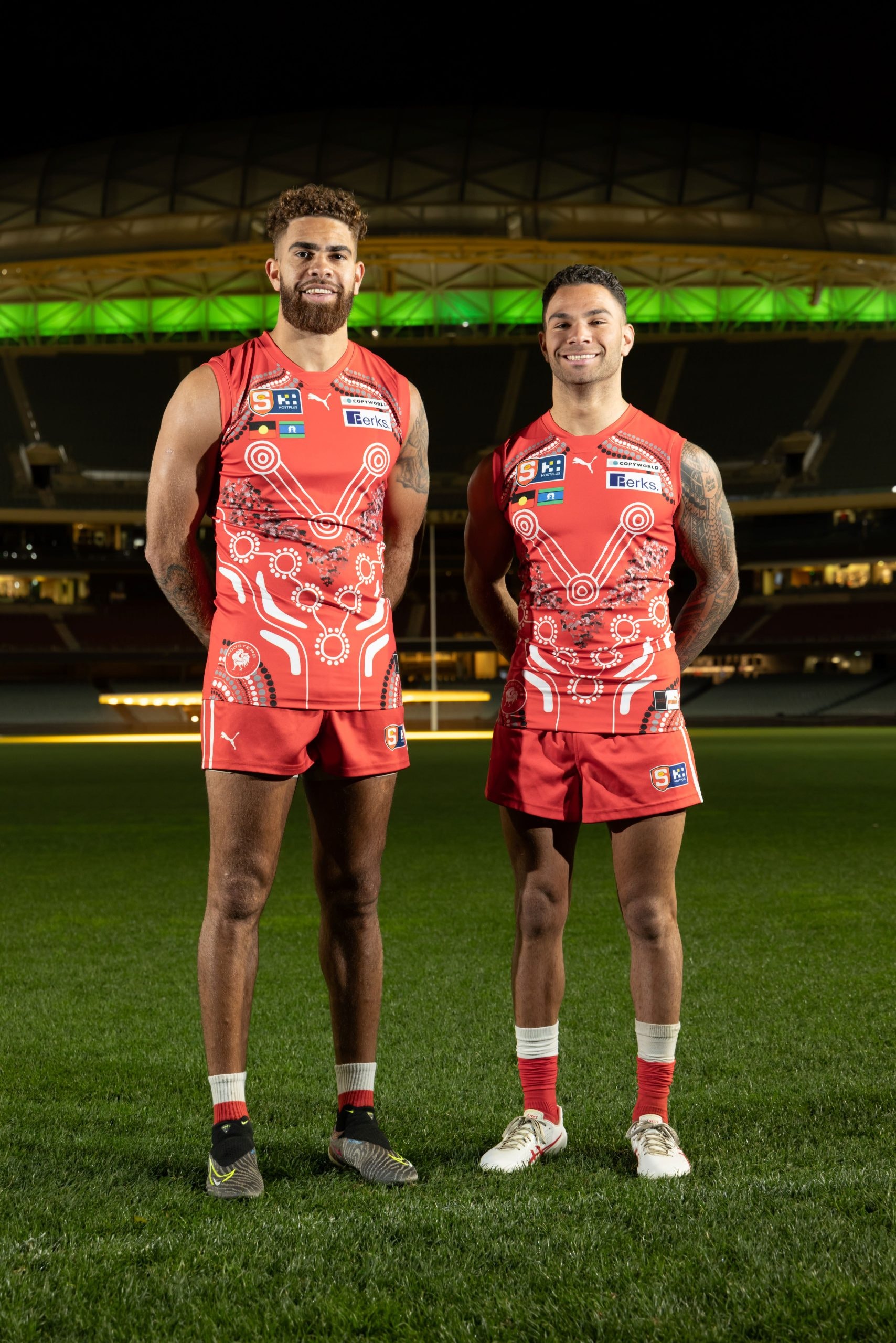
Nigel Lockyer and Frank Szekely
Norwood’s First Nations Round guernsey was designed by SANFLW player Tesharna Maher and was also worn in the inaugural Hostplus SANFLW League First Nations Round earlier this year.
Tesharna is a Western Aranda, Yankunytjatjara Pitjantjatjara , Yamaitji (Fathers’ side), Kokatha and Gurrinji (mothers side) woman.
“I was born in Darwin on Larrakia Land and regularly travel through Alice Springs (Arrernte Land) to spend time on my homelands before eventually arriving back on Kaurna Land – my final destination in my journey so far.
“My family moved to SA because my dad was playing footy down here so I have lived most of my life in Adelaide, but I have a strong connection to the Northern Territory.”
The design includes the story of Tesharna’s journey from Darwin to Adelaide as a child, her totem (the Willie Wagtail), the ‘big meeting place’ – Norwood Football Club and oval – and the other SANFL clubs.
“My totem dreaming is the Willie Wagtail,” she said.
“I come from a long line of cultural knowledge that was passed down from my grandmother’s country – Ntaria (Hermannsburg). When we are born we are assigned an animal that depicts our spiritual knowledge to the country (Pmarra).
“As a child I showed and still do show significant resemblance to the Willie Wagtail, its movements and traits. Showing these traits shows how powerful my culture is.
“My totem is known to travel a lot and is a highly spiritual bird that has strong connections to Uluru, where my great great grandmother Auguste was born. I have been told many stories from my grandmothers, that I would show up to their houses and tap on their windows to let them know I was outside.”
Visit the Norwood FC website to view the full design description.
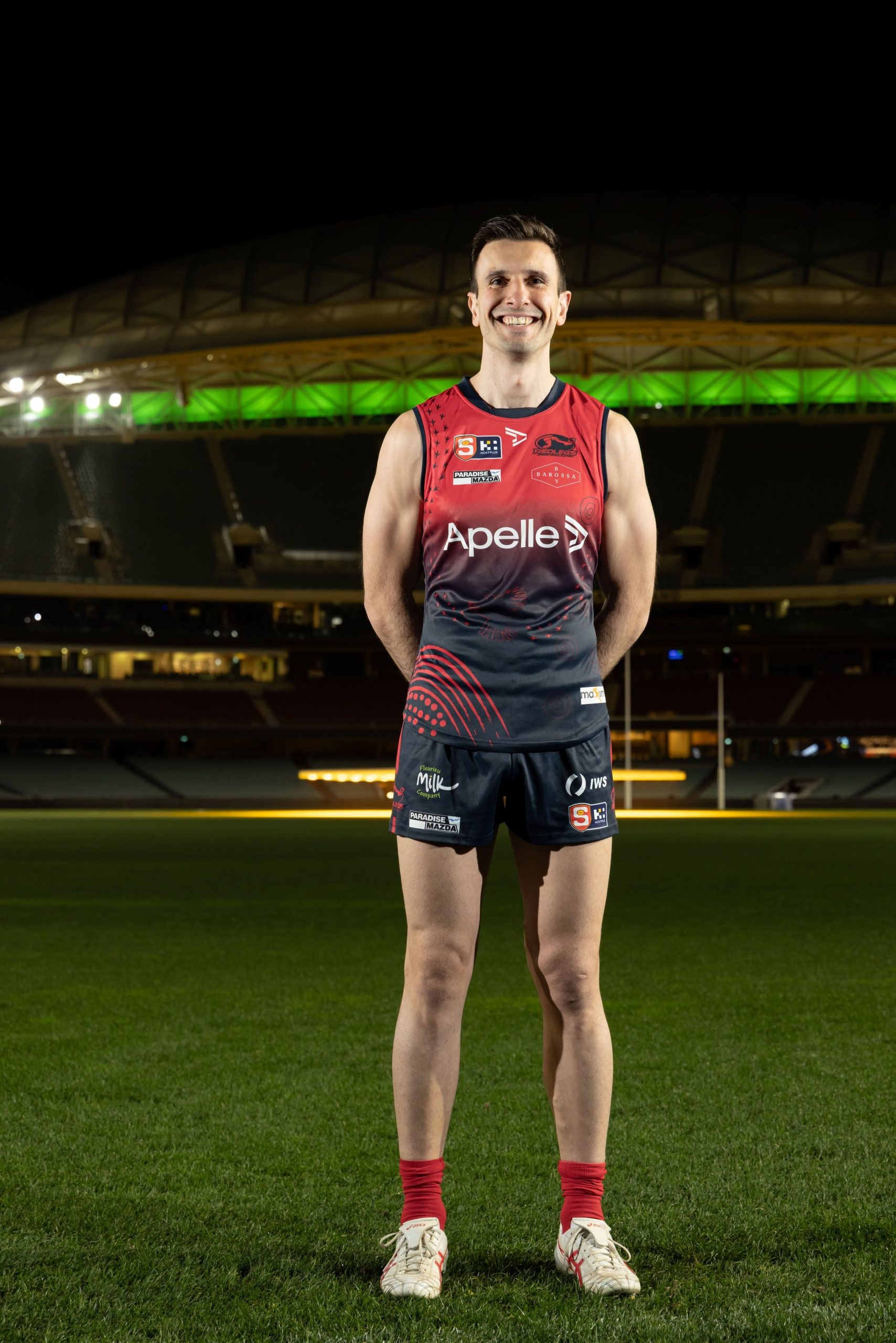
Matt Panos
This year’s striking design was a collaboration between two-time Yartapuulti premiership player Peter Burgoyne and Adelaide artist Laz Gein.
The guernsey depicts several generations of Burgoynes including Peter’s son and current Yartapuulti player, Jase Burgoyne and Mirning and Kokatha elder Peter Burgoyne Snr, who played SANFL football for Yartapuulti in the 1970s.
The front of the guernsey centres around a beautifully intricate eagle – the totem of Peter Burgoyne’s grandfather, with its wings forming the classic ‘V’ shape and its feathers also represented within the playing numbers on the back of the jumper.
A majestic southern right whale is shown across the back of the strip, with emu tracks surrounding it on either side.
The whale is a sacred animal and a cultural totem of Burgoyne’s grandmother and the tracks signify the journey of the Burgoyne family so far.
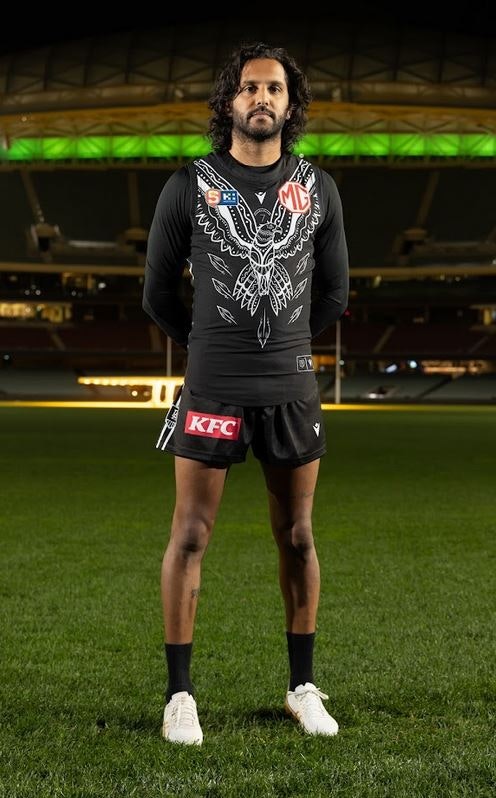
Anthony Wilson.
Designed by Temaana Sanderson-Bromley, South Adelaide’s First Nations Round guernsey contains many themes.
It depicts Aboriginal culture and knowledges, the landscape and the location of the club, the club community and history, and coming together in the spirit of reconciliation.
Front of Guernsey
South Adelaide Football Club is located at Noarlunga in the southern suburbs of Adelaide.
The Kangaroo tracks in the design represents Tarndanya – Adelaide, the ‘place of the red kangaroo.’
The dominant line that bends and stretches across the front (and back) of the jersey represents the Onkaparinga River and southern Adelaide.
The design on the top half of the jersey, above the river, pays respect to the traditional custodians, the Kaurna people, and their history and ongoing connection to the land.
It also represents First Nations people’s knowledges and the diversity of First Nations peoples and cultures.
Symbolism includes people, meeting places and gathering together, landscape features such as water, vegetation, bush foods and the hills, hunting and fishing, and travelling to meet others.
The smaller kangaroo and emu tracks represent movement and activity, such as people’s movement, their learning and their journeys.
The designs within the ‘S’ and ‘A’ represents the club’s history and recognition of the First Nations community, and its ongoing commitment in working towards reconciliation.
In the bottom section of the jersey are a series of concentric circles.
The larger circle under ‘S’ ‘A’ represents the club’s players, coaches/leadership and the general club membership.
The inside design is the coaches, the ‘u’ shapes around them are the players, and the surrounding dots are the fans, supporters and club community.
The four smaller dotted concentric circles each represent different elements of the club – Men’s teams, Women’s teams, Junior teams and Coaches/Leaders and Staff.
Rear of Guernsey
The rear of the guernsey continues the design from the front, featuring the Onkaparinga River representing South Adelaide and the knowledges and culture held within the landscape and by the First Nations community.
The dots around arms and neck represent South Adelaide’s 37 Hall of Fame club inductees.
The four circles in the bottom right-hand corner represent South Adelaide’s current First Nations players.
The 13 stars on the front and back of the jersey, against the dark blue background, represent South’s 13 premiership flags.
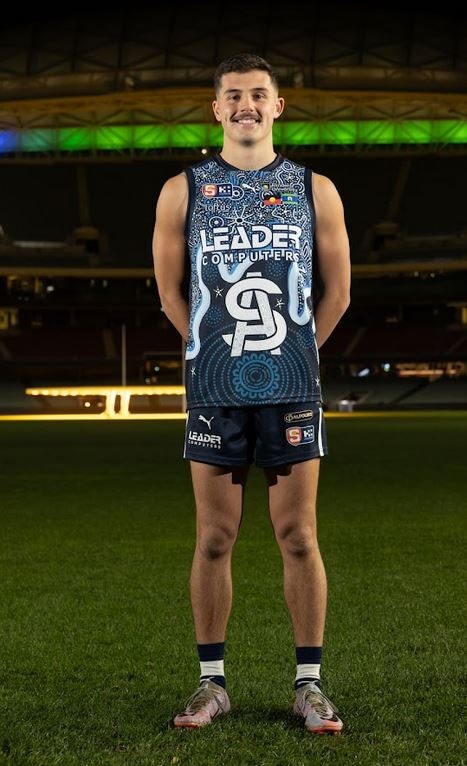
Hayden Sampson.
Sturt Football Club proudly unveils its extraordinary Indigenous guernsey for the season, designed in collaboration by Eastern Arrernte Man Pat Caruso and Kuarna, Ngarrindjeri, Arrabunna Man Shane Tongerie. This year’s guernsey encapsulates the club’s journey forward, breaking barriers, and driving change.
The contrasting light and dark blue hues symbolise not only Sturt’s colours but the club’s unwavering commitment to protecting its home against adversaries. The depiction of feet represents the development squads’ path to senior football, showcasing the club’s dedication to nurturing talent.
An important element of the design is the representation of the seven sisters, paying homage to the strong women within the club who continuously strive for success. The kangaroo tracks signify the club’s forward movement, emphasizing the importance of progress and never looking back.
The stars of the Southern Cross, which served as a compass to Aboriginal peoples, symbolises the ongoing journey of moving forward and finding one’s way.
Additionally, the number 4 displayed on the right shoulder holds special significance as it represents the club’s first Indigenous premiership player, Roger Rigney, who now serves as an Elder. This aligns with the theme of this year’s NAIDOC week, for the Elders, highlighting the invaluable wisdom and leadership of Elders within the community.
Sturt Football Club’s Indigenous guernsey stands as a powerful symbol of unity, resilience, and the pursuit of success. It is a testament to the club’s commitment to acknowledging and celebrating Aboriginal culture and heritage, both on and off the field.
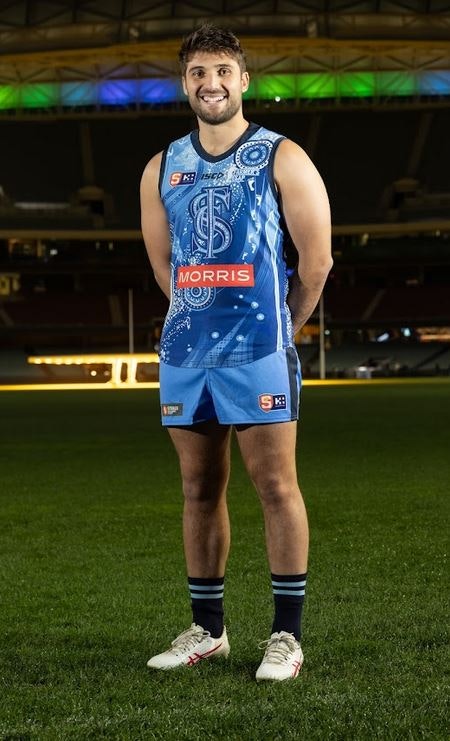
James Battersby
West Adelaide’s guernsey was proudly designed by students at Maitland Lutheran School.
The strip of three lines across the front represent the flowing water of the River Murray, with the club’s connection to the Riverland, part of its regional zone.
The swan totem is a feature, with the large swan at the bottom representing the home of the club, Hisense Stadium, and an inner circle representing the club as a place of coming together.
Stars on the front connect the people at the club to their ancestors and each other.
The back of the guernsey continues the Riverland theme and connection, with the lines of the flowing water. It also features the Eaglehawk totem of the Riverland, with the Kaurna shield for battle on the bird.
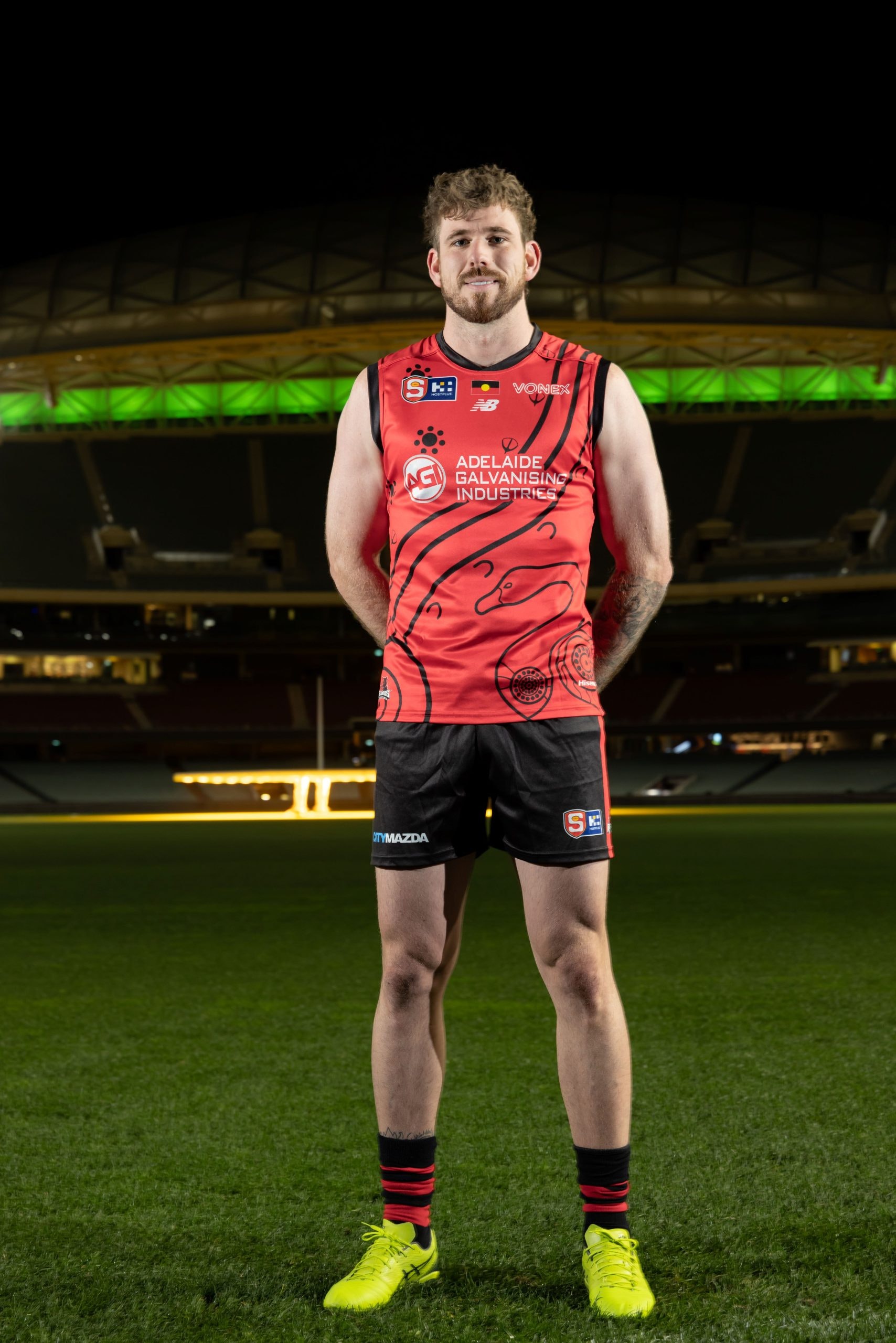
Kaiden Brand
Woodville-West Torrens’ First Nations Round guernsey was designed by Club board member Devinia Binell.
Devinia is a proud Barngarla-Kokatha-Wirangu woman and the club was honoured to have her design move from its polo tops in 2021 to guernseys.
Devinia explains the design:
“The painting represents my understanding of how important it is to recognise the WWTFC as a true community club. The club has many relationships and partnerships with varying organisations, community groups, and First Nations People. In the artwork, I have tried to capture this and show the many and varying connections.
The large circles represent the WWTFC, with the five smaller circles representing the important connections and valued partnerships with the SANFL community, past and resent players, WWTFC supporters, Community Football clubs and most importantly, Aboriginal and Torres Strait Islander Peoples.”
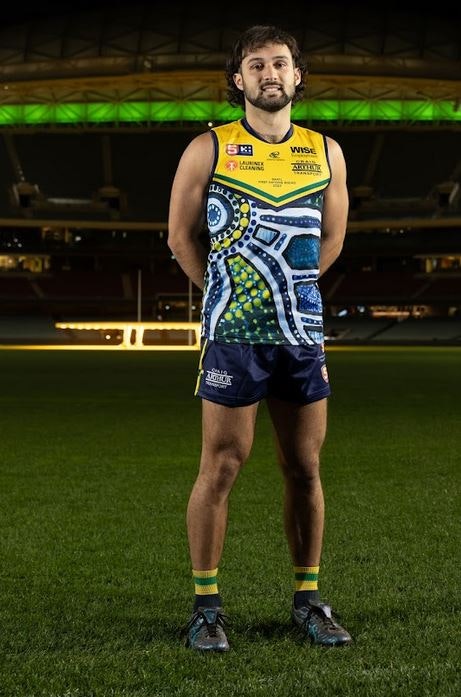
Tyran Hill
Related News
-
 Hostplus League
Hostplus LeagueRound 13 Health Partners SANFL Injury Report
Health Partners -
 Snapshot
SnapshotRound 13 Hostplus SANFL Snapshot – Saturday
-
 Match Preview
Match PreviewRound 13 Hostplus SANFL League Match Previews
-
 Team Selections
Team SelectionsRound 13 Hostplus SANFL League Teams
-
 Milestone
MilestoneJosh Hones in on his 200th Hostplus SANFL League match
-
 Hostplus League
Hostplus LeagueRound 12 Health Partners SANFL Injury Report
Health Partners -
 Snapshot
SnapshotRound 12 Hostplus SANFL Snapshot – Sunday
-
 Snapshot
SnapshotRound 12 Hostplus SANFL Snapshot – Saturday







